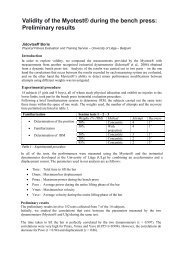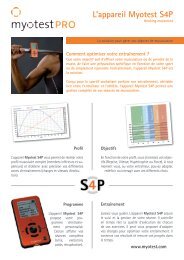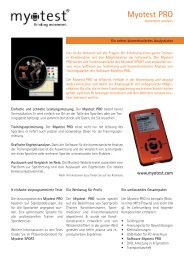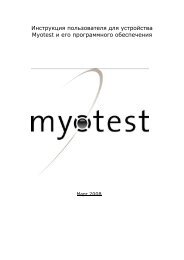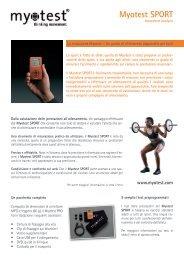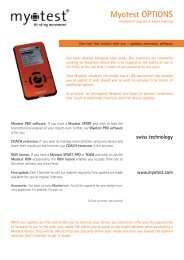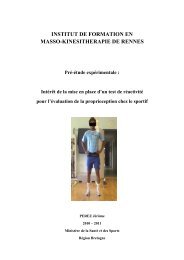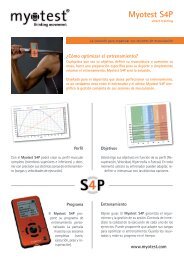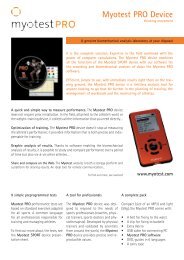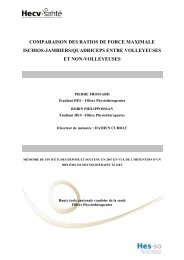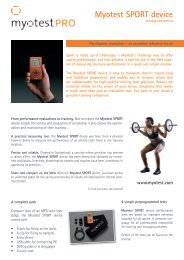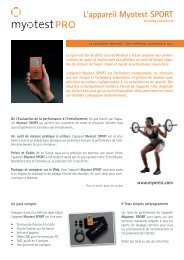Validity of Myotest® during a vertical jump test: Preliminary study
Validity of Myotest® during a vertical jump test: Preliminary study
Validity of Myotest® during a vertical jump test: Preliminary study
- No tags were found...
You also want an ePaper? Increase the reach of your titles
YUMPU automatically turns print PDFs into web optimized ePapers that Google loves.
<strong>Validity</strong> <strong>of</strong> <strong>Myo<strong>test</strong>®</strong> <strong>during</strong> a <strong>vertical</strong> <strong>jump</strong> <strong>test</strong>:<strong>Preliminary</strong> <strong>study</strong>Nicolas Babault, Gilles ComettiCentre d'expertise de la performance (Performance expertise center) – Faculty <strong>of</strong> SportSciences – Dijon – FranceIntroductionThe <strong>vertical</strong> <strong>jump</strong> is a fundamental quality for athletes. The evaluation <strong>of</strong> this quality is thusessential when monitoring a person’s physical training. Several <strong>test</strong>s and evaluation systems canbe deployed to assess this quality. The aim <strong>of</strong> this experiment was to check the validity <strong>of</strong> the<strong>Myo<strong>test</strong>®</strong> for measuring <strong>vertical</strong> <strong>jump</strong> <strong>test</strong>s. The experiment involves comparing twomeasuring systems to measure <strong>vertical</strong> movement <strong>during</strong> squat <strong>jump</strong>s (SJ) and a reactivity <strong>test</strong>.Experimental procedureSubjects. 30 subjects (6 girls and 24 boys), all <strong>of</strong> whom <strong>study</strong> physical education, took part inthe <strong>study</strong>.Each subject was evaluated randomly by means <strong>of</strong> the two <strong>vertical</strong> displacement <strong>test</strong>s:The squat <strong>jump</strong> (SJ) and reactivity <strong>test</strong>.Tests. The SJ allows measurement <strong>of</strong> “non-pliometric” displacement and the ability todevelop a great deal <strong>of</strong> strength within a very short space <strong>of</strong> time (explosiveness).This <strong>test</strong> consisted <strong>of</strong> the person <strong>jump</strong>ing as high as possible with their hands on their hipsfrom a half-squat position (i.e. 90° bending <strong>of</strong> the knees).This position was maintained for about 1s. The subjects were then instructed to extend thelower limbs as explosively as possible with the aim <strong>of</strong> performing a squat <strong>jump</strong>.Three attempts were made at this exercise. The best result was retained for analysis.The reactivity <strong>test</strong> allows us to measure the calf muscle power. The subjects performed 6<strong>vertical</strong> <strong>jump</strong>s (with as little bending <strong>of</strong> the knees as possible) with their arms as support.The idea was to achieve the least possible contact time for a maximum <strong>jump</strong> height.The <strong>test</strong> was only performed once.The average height <strong>of</strong> the 6 <strong>jump</strong>s was calculated and then compared.Equipment used. The <strong>jump</strong> heights were simultaneously recorded using two evaluationsystems.The <strong>Myo<strong>test</strong>®</strong> (Myo<strong>test</strong>, Sion, Switzerland) system allows you to calculate the <strong>jump</strong> heightusing an accelerometer placed on the pelvis with integration calculations, allowing you todetermine the sensor’s <strong>vertical</strong> displacement (i.e. <strong>jump</strong> height).
The <strong>jump</strong> height can also be determined by measuring the airborne time with an Ergo<strong>jump</strong>(Globus Italia, Codogne, Italy) contact mat.Statistical analysis. The values obtained from the two measurement systems are compared per<strong>test</strong> student.The correlations are then researched to establish the degree <strong>of</strong> association between theperformances recorded by the two systems.A significance threshold <strong>of</strong> 0.05 was adopted for all <strong>of</strong> the statistical analyses.ResultsThe <strong>jump</strong> height comparison gained from the <strong>Myo<strong>test</strong>®</strong> and the Ergo<strong>jump</strong> did not show anysignificant differences (see table 1). Nevertheless, the <strong>jump</strong> heights are slightly higher withthe <strong>Myo<strong>test</strong>®</strong> when compared to those <strong>of</strong> the Ergo<strong>jump</strong>. This difference was approx. 3 cm,meaning a relative average difference <strong>of</strong> 9.5%.Ergo<strong>jump</strong> (cm) <strong>Myo<strong>test</strong>®</strong> (cm) Difference (cm) Difference (%)Squat Jump (n =30)Average 32.1 34.8 2.7 8.7Standard deviation 6.3 7.0 2.8 9.1Averagestandard deviationTable 131.Reactivity (n = 20)34.6 3.07.2 3.35Heights <strong>of</strong> the squat <strong>jump</strong> <strong>test</strong>s and reactivity measured withthe <strong>Myo<strong>test</strong>®</strong> and Ergo<strong>jump</strong>.10.712.5Relations between the <strong>jump</strong> heights measured with the <strong>Myo<strong>test</strong>®</strong> and Ergo<strong>jump</strong> are shown infigure 1. Significant correlations were achieved for the SJ and reactivity <strong>test</strong> (P < 0.001).Figure 1 – Correlations between the <strong>jump</strong> heights <strong>of</strong>the Ergo<strong>jump</strong> and <strong>Myo<strong>test</strong>®</strong> <strong>during</strong> the SJ (A, r² = 0.84, P < 0.001) andreactivity <strong>test</strong> (B, r² = 0.87, P < 0.001).
ConclusionThe aim <strong>of</strong> this experiment was to check the validity <strong>of</strong> the <strong>Myo<strong>test</strong>®</strong> <strong>during</strong> <strong>vertical</strong> <strong>jump</strong><strong>test</strong>s. The preliminary results show a significant correlation between this system and theErgo<strong>jump</strong> for both the SJ and the reactivity <strong>test</strong>. A difference <strong>of</strong> about 9% was recorded infavor <strong>of</strong> the <strong>Myo<strong>test</strong>®</strong>. This difference can be explained due to the measurement method andthe calculation method used. The contact mat takes the airborne time into account whereas the<strong>Myo<strong>test</strong>®</strong> only measures the acceleration <strong>of</strong> the center <strong>of</strong> gravity <strong>during</strong> the ground contactphase. The <strong>Myo<strong>test</strong>®</strong> therefore appears to be an efficient tool for evaluating performance<strong>during</strong> the <strong>vertical</strong> <strong>jump</strong> <strong>test</strong>. However, complementary studies need to be carried out to roundout this <strong>study</strong>. Such studies could include (i) a comparison <strong>of</strong> the <strong>Myo<strong>test</strong>®</strong> with othersystems (e.g. force platform) using parameters such as take-<strong>of</strong>f speed or power or (ii) a <strong>test</strong>involving the reproducibility <strong>of</strong> the measurements.



